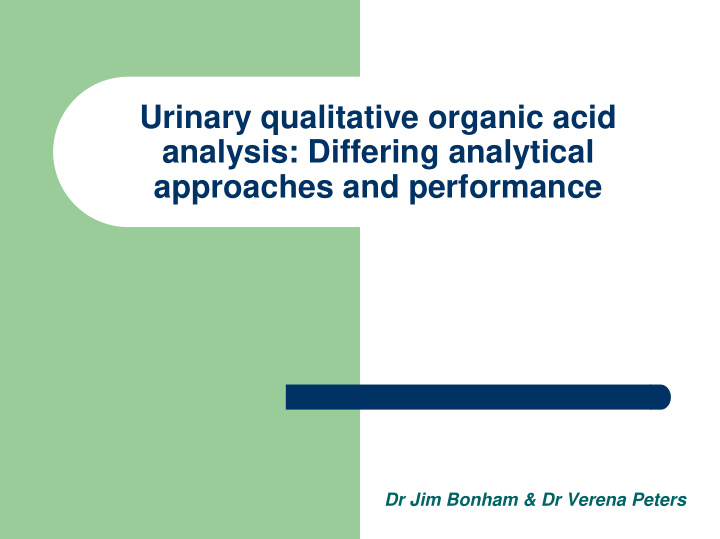



Urinary qualitative organic acid analysis: Differing analytical approaches and performance Dr Jim Bonham & Dr Verena Peters
Scheme design � Nine heat treated urine samples per year from real patients with differing metabolic disorders � Participants are asked to: – Identify the major analytical findings – Indicate the most likely diagnosis – Suggest any further investigations needed to confirm or clarify the diagnosis
Samples circulated � Maple syrup urine disease � Propionic aciduria � Medium chain acyl CoA dehydrogenase deficiency � 4-hydroxybutyric aciduria � DOPA metabolites � 3-methycrotonyl CoA carboxylase defn � Glutaric aciduria type 1 � Primay hyperoxaluria type 1 � D-glyceric aciduria � Malonic acidria � Methylmalonic aciduria � Urea cycle disorder � Fumarate hydratase deficiency
Samples circulated � Isovaleric aciduria � Mevalonic aciduria � Multiple acyl CoA dehydrogenase deficiency � 2-hydroxyglutaric aciduria � Methyl glutaconic aciduria � Ethylene glycol poisoning � Phenylketonuria � Pyroglutamic aciduria � Dihydropyrimidine dehydrogenase deficiency � Holocarboxylase synthetase deficiency � Beta ketothiolase deficiency � Valproate therapy
Scoring � Satisfactory 2 � Helpful but incomplete 1 � Unhelpful 0 � Slightly misleading -1 � Misleading -2 Total annual achievable 18
Score and variation in performance – 10 years experience
Methodological approaches GCMS 82/84 � Ethylacetate extraction or similar 79/84 � TMS derivitisation 83/84 � Oximation 50/84 � Int std used 82/84 � Int QC used 50/84 � Average age of equipment 7.2 y � Average number of peaks annotated 47 �
Interpretative approaches Extracted ion chromatograms used 71/84 � to aid identification Auto-naming software used 40/84 � Grade of staff used to annotate 18 non graduate � 66 graduate Regular staff rotation 25/84 � Grade of staff used to interpret 2 non graduate � 82 graduate Regular staff rotation 8/84 � Group vs Individual interpretation 29 vs 55 �
Other analytical factors � Average length that the service has been offered 16 y Average annual workload (samples/y) 1046 � Average sample turnaround time 8d � Out of hours service available 26/84 � Average cost (where stated) 113 Euro �
Workload vs Score
Number of peaks named vs Score
Years service offered vs Score
Assay cost
Factors without association � No association with oximation � No association with grade of staff or rotation � No association with use of auto-naming software � No association with group or individual interpretation � No association with the spectral library used � No association with the use of extracted ion chromatograms � No association with the turnaround time offerred
Conclusions � There is a great deal of consistency of approach � It is possible to do consistently badly � Belong to an EQA scheme and take the results seriously � Consider the need to offer a service very carefully if the annual workload is less than 500/annum � Annotate exhaustively � Do worry too much about the subtleties of approach but do whatever you do thoughtfully and carefully
SSIEM attendance
Recommend
More recommend